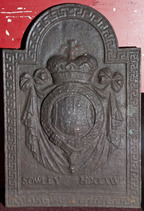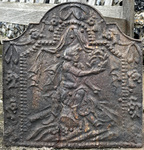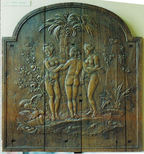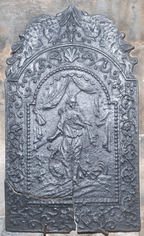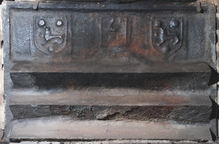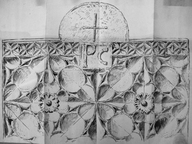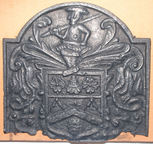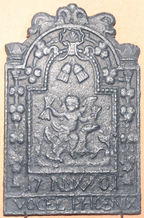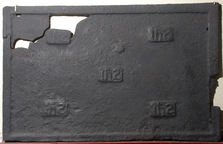-
1108
Description: Arched rectangular shape; Greek Key border with fillet edges; in high relief, in front of swagged drapery, the shield of, quarterly, France quartering England, Scotland and Ireland, surrounded by a Garter, and surmounted by a ducal coronet; below, the inscription in capitals.
Notes: The use of the Greek Key design as a border is believed to be unique for an English fireback. Although somewhat indistinct, the use of the Stuart royal arms and the ducal coronet can be explained by the fact that the fireback was one of a group cast for the 2nd Duke of Richmond, whose father, the 1st duke, was the illegitimate son of Charles II and Louise de Kéroualle. The Richmond arms were differenced from the Stuart royal arms by the addition of a bordure compony (the detail of which is not distinct on this casting). Sowley Furnace, near Beaulieu in Hampshire, was owned in 1732 by John, 2nd Duke of Montagu, and was let to Miles Troughton. Similar, but larger, variants of this fireback are at Goodwood House, the seat of the Dukes of Richmond, where this fireback is likely to have once been. Criterion Auctions, Islington, 7 Jan 2019, lot 128 (£50).
Inscription: HONI SOIT QUI MAL Y PENSE / SOWLEY MDCCXXXII
Arms: Duke of Richmond
- Decoration tags:
- rectangular with round arch (shape)
- fillet (edging)
- carved pattern panels
- heraldic
- armorial
- royal
- text
Manufactured: in 1732 at Sowley Furnace, Beaulieu in the New Forest area of England.
Current location: not known.
-
355
Description: Rectangular joined to pediment by symmetrical scrolls; fillet edging with embattling inside; shield, helm, crest, supporters and mantling of the city of Bristol; date split by bottom of shield; inscription in an oval cartouche below shield.
Notes: Both '3's in the date are a substitution, with another casting suggesting an original date of 1614 or 1624. The pattern-maker was also responsible for carving royal coats of arms in three West Country churches and a small number of series of firebacks in the first quarter of the 17th century. A variant with side extension panels is no. 952.
Copies of this fireback are known.
Inscription: 16 33 / [ARMES] BRISTOLL
Arms: City of Bristol
- Decoration tags:
- rectangular with detached pediment (shape)
- fillet (edging)
- whole carved pattern
- individual numbers
- armorial
- text
Manufactured: in 1633 possibly in the Forest of Dean area of England.
Current location: Kenilworth Castle, Kenilworth, Warwickshire, England.
Museum number: 88278827 (part of the English Heritage museum group)
- Attached to series:
- Civic firebacks
- Bristol armorial group
-
1253
Description: Central panel of arched rectangular shape with cavetto canted corners and bead edging; figure seated astride a triumph of weaponry (cannon, spears, drums), holding a laurel wreath in his right hand, surrounded by martial objects (flags, cannon, drums etc.), symmetrical hanging drapery above; same-shaped border with fillet edging and suspended ribbons with floral bunches
Notes: Possibly a depiction of an allegory of Victory. Other firebacks have the same distinctively shaped central panel and border shape, suggesting the same pattern maker. A reduced variant of a more elaborate fireback (no. 456) but missing mirrored serpents on top and probable reed decoration at the base.
- Decoration tags:
- rectangular with canted top corners and round arch (shape)
- fillet (edging)
- whole carved pattern
- pictorial
- humans
- plants
Manufactured: in the late-17th to early-18th century possibly in the Weald area of England.
Current location: in private hands, Kingsdown, Kent, England.
- Attached to series:
- Mayfield 'Dutch' series
- British 'Dutch' style firebacks
-
934
Description: Carved wooden fireback pattern. Arched rectangular shape with fillet and astragal edging; pictorial scene of The Three Graces in an exotic rural setting, with a palm tree, roses and ?doves.
Notes: The detail of the carving is very fine
- Decoration tags:
- rectangular with round arch (shape)
- fillet (edging)
- whole carved pattern
- planklines
- pictorial
- mythological
- humans
- plants
- objects
Manufactured: in the 18th century in France.
Current location: Haardplatenmuseum Klarenbeek, Oude Broekstraat 12, Klarenbeek, Netherlands.
- Attached to series:
- Patterns
-
358
Description: Arched rectangular central panel with bead edging on a broad fillet; standing on a ground with a peacock behind her, a classically-dressed figure of a female, wearing a crown and holding a sceptre in her right hand, her left hand across her chest; above her, swagged drapery; arched rectangular border with fillet edging; central scallop shell at the top with a descending arrangement of swirled and interlinked lines; at bottom centre, a cartouche bearing the letter ‘N’; on top, two mirrored serpents.
Notes: The figure is that of Hera/Juno. The pattern maker identified as ‘N’ is likely to have been working in collaboration with pattern makers whose fireback designs are identified with the initials, SHR and EB, and with the maker responsible for patterns made in 1724, some of which bore inscriptions in Welsh.
Inscription: N
- Decoration tags:
- 'Dutch' (shape)
- fillet (edging)
- whole carved pattern
- pictorial
- mythological
- text
- animals
- humans
Manufactured: in the early-18th century in England.
Current location: Baddesley Clinton Hall, Knowle, Warwickshire, England.
Museum number: 342886 (part of the National Trust museum group)
- Attached to series:
- N series
- British 'Dutch' style firebacks
-
359
Description: Rectangular; double fillet moulded edging; top centre, shield-shaped block with a rectangle containing the crest of the Fowles - an Arm in armour holding a Battle axe issuant from a Ducal Coronet, above the initials, WF; top left and right, two shields of the arms of the Fowle family - (Gules) a lion passant guardant between three roses (Or); across the lower half of the fireback are three solid triangular prisms of iron.
Notes: The stamps relate to William Fowle (1568-1634), ironmaster of Riverhall furnace. The stamps also appear on grave slabs in Wadhurst and Frant churches and on an unprovenanced graveslab in Maidstone Museum. The iron prisms were included, perhaps, to retain heat and to prevent the fireback from cracking.
Inscription: WF
Arms: William Fowle, of Frant and Wadhurst
- Decoration tags:
- rectangular (shape)
- fillet (edging)
- carved stamps
- heraldic
- armorial
- text
Manufactured: in the early-17th century probably at Riverhall Furnace, Wadhurst in the Weald area of England.
Current location: in private hands, Lamberhurst, Kent, England.
- Attached to series:
- Fowle series
-
1083
Description: Arched rectangular shape; fillet edging (top and sides); twisted rope cross in centre of arch; fillet-edged square below arch containing initials of uneven size; along the top, a line of five quatrefoils on each side of the initials; below, two symmetrically carved roundels and associated spandrels, each with a central flower.
Notes: The quatrefoils and roundels are likely to have been part of a redundant, probably medieval, furniture panel, perhaps from a chest. The life-size rubbing, reinforced with ink, is by W. R. Lethaby. The fireback was formerly property of the artist John Callcott Horsley RA (1817-1903) at Wilsley Green, Cranbrook, Kent.
Inscription: PC
- Decoration tags:
- rectangular with round arch (shape)
- fillet (edging)
- carved pattern panels
- apotropaic
- text
- objects
Manufactured: in the mid- to late-16th century possibly in the Weald area of England.
Current location: Victoria & Albert Museum, Cromwell Road, Kensington & Chelsea, London, England.
Museum number: 3267-1932 (part of the Victoria & Albert Museum museum group)
Citation: Lethaby, W. R., 1 Oct 1926, 'English Cast Iron - I', The Builder, 131, no. 4365, pp. 537-8.
- Attached to series:
- Miscellaneous pattern firebacks
-
376
Description: Arched rectangular shape; fillet edge on top and sides. Shield, helm, crest and mantling of the Worshipful Company of Joiners and Ceilers.
Notes: Blazon: Gules a Chevron Argent between in chief two pairs of Compasses extended at the points and in base a sphere Or. On a chief of the second a pale Azure between two Roses of the field barbed and seeded proper, the pale charged with an Escallop of the second; Crest: a demi Savage proper wreathed about the head and waist with Leaves Vert holding in the dexter hand over the shoulder a Tilting Spear Or headed Argent; arms granted 1571.
Copies of this fireback are known.
Arms: Worshipful Company of Joiners and Ceilers
- Decoration tags:
- rectangular with round arch (shape)
- fillet (edging)
- whole carved pattern
- armorial
Manufactured: in the mid-17th century possibly in the Weald area of England.
Current location: Anne of Cleves House, Southover High Street, Lewes, East Sussex, England.
Museum number: LH000.938 (part of the Sussex Archaeological Society museum group)
- Attached to series:
- Livery company firebacks
-
377
Description: Arched rectangular central panel with bead on fillet edging and two tassels hanging from top of arch; pictorial image of a cherub with arrows in both hands sitting on a phoenix; arched rectangular border with fillet edging; scallop shell at top with descending ribbons and fruit clusters; date and monogram below central panel; bottom panel with inscription; on top, two sea serpents, with open buds on shoulders of recatngle.
Notes: The customary monogram on such firebacks is NDV. Several anglicised versions of this type of fireback exist. Formerly part of the J. H. Every collection.
Copies of this fireback are known.
Inscription: 17 NDW 01 / VOGEL PHOENIX [bird phoenix]
- Decoration tags:
- 'Dutch' (shape)
- fillet (edging)
- whole carved pattern
- pictorial
- mythological
- text
- humans
Manufactured: in 1701 in the Siegerland area of Germany.
Current location: Anne of Cleves House, Southover High Street, Lewes, East Sussex, England.
Museum number: 1944.24.087 (part of the Sussex Archaeological Society museum group)
- Attached to series:
- 'Dutch' NDW series
-
382
Description: Rectangular; broad fillet edging; 'IhS' stamp repeated five times (4-1-4) centrally.
Notes: The use of the christogram suggests a Catholic, and therefore a possibly pre-Reformation or Marian date.
Inscription: IhS [repeated 5 times]
- Decoration tags:
- rectangular (shape)
- fillet (edging)
- carved stamps
- text
Manufactured: in the early- to mid-16th century in the Weald area of England.
Current location: Anne of Cleves House, Southover High Street, Lewes, East Sussex, England.
Museum number: 1944.24.036 (part of the Sussex Archaeological Society museum group)
- Attached to series:
- Religious firebacks
